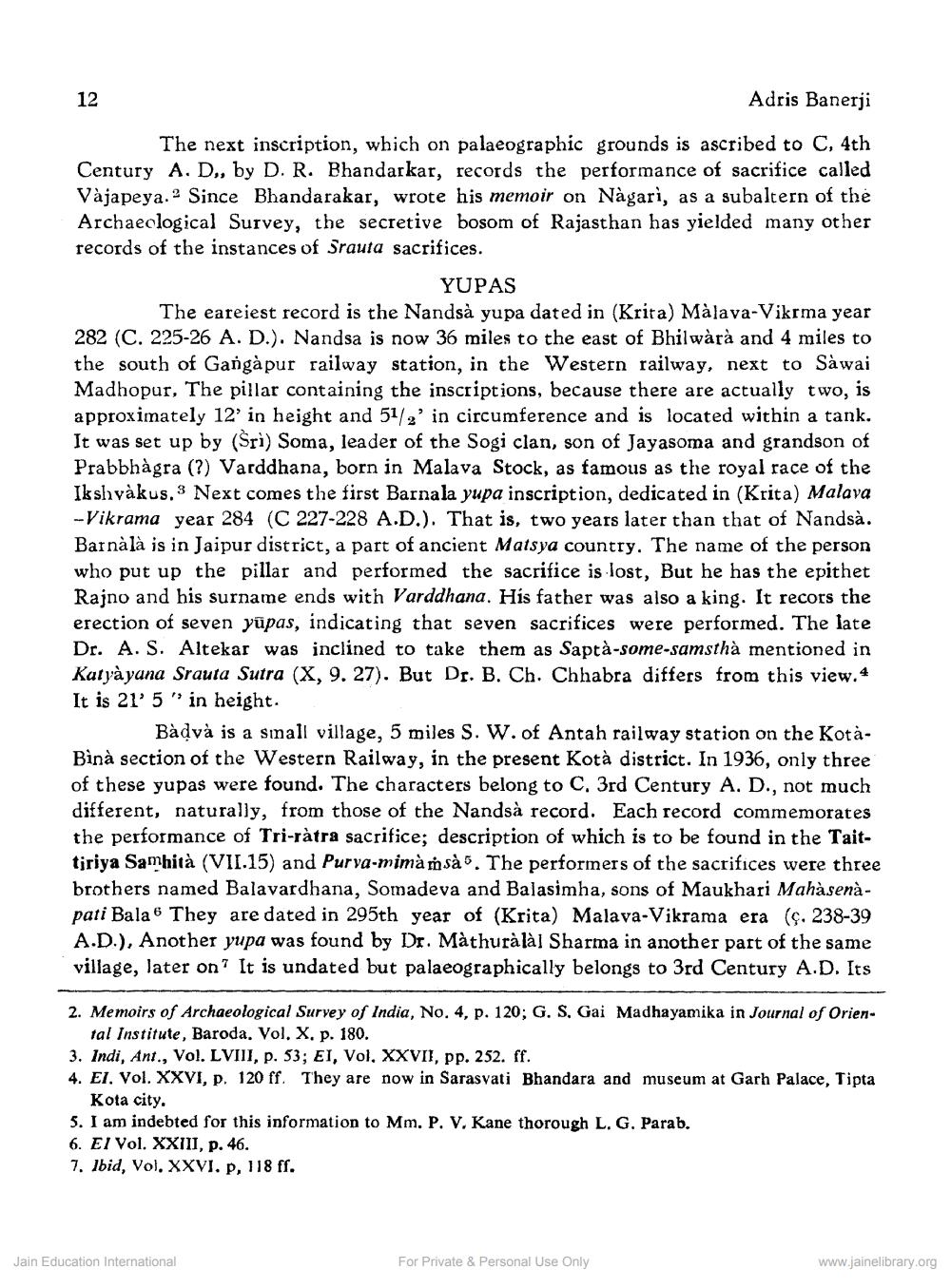Book Title: Religious Conditon in SE Rajasthan from early Inscriptions Author(s): Adris Banerji Publisher: Z_Jinvijay_Muni_Abhinandan_Granth_012033.pdf View full book textPage 2
________________ Adris Banerji The next inscription, which on palaeographic grounds is ascribed to C, 4th Century A. D,, by D. R. Bhandarkar, records the performance of sacrifice called Vàjapeya. Since Bhandarakar, wrote his memoir on Nàgari, as a subaltern of the Archaeological Survey, the secretive bosom of Rajasthan has yielded many other records of the instances of Srauta sacrifices. 121 YUPAS The eareiest record is the Nandsà yupa dated in (Krita) Màlava-Vikrma year 282 (C. 225-26 A. D.). Nandsa is now 36 miles to the east of Bhilwàrà and 4 miles to the south of Gangapur railway station, in the Western railway, next to Sawai Madhopur, The pillar containing the inscriptions, because there are actually two, is approximately 12' in height and 51/2' in circumference and is located within a tank. It was set up by (Sri) Soma, leader of the Sogi clan, son of Jayasoma and grandson of Prabbhagra (?) Varddhana, born in Malava Stock, as famous as the royal race of the Ikshvakus. Next comes the first Barnala yupa inscription, dedicated in (Krita) Malava -Vikrama year 284 (C 227-228 A.D.). That is, two years later than that of Nandsà. Barnala is in Jaipur district, a part of ancient Matsya country. The name of the person who put up the pillar and performed the sacrifice is lost, But he has the epithet Rajno and his surname ends with Varddhana. His father was also a king. It recors the erection of seven yupas, indicating that seven sacrifices were performed. The late Dr. A. S. Altekar was inclined to take them as Saptà-some-samsthà mentioned in Katyayana Srauta Sutra (X, 9. 27). But Dr. B. Ch. Chhabra differs from this view.* It is 21' 5" in height. Bàdvà is a small village, 5 miles S. W. of Antah railway station on the KotaBinà section of the Western Railway, in the present Kotà district. In 1936, only three of these yupas were found. The characters belong to C, 3rd Century A. D., not much different, naturally, from those of the Nandsà record. Each record commemorates. the performance of Tri-ràtra sacrifice; description of which is to be found in the Taittiriya Samhità (VII.15) and Purva-mimàmsà. The performers of the sacrifices were three brothers named Balavardhana, Somadeva and Balasimha, sons of Maukhari Mahasenàpati Bala They are dated in 295th year of (Krita) Malava-Vikrama era (s. 238-39 A.D.), Another yupa was found by Dr. Màthuràlàl Sharma in another part of the same village, later on? It is undated but palaeographically belongs to 3rd Century A.D. Its 2. Memoirs of Archaeological Survey of India, No. 4, p. 120; G. S. Gai Madhayamika in Journal of Oriental Institute, Baroda. Vol. X. p. 180. 3. Indi, Ant., Vol. LVIII, p. 53; EI, Vol. XXVII, pp. 252. ff. 4. EI. Vol. XXVI, p. 120 ff. They are now in Sarasvati Bhandara and museum at Garh Palace, Tipta Kota city. 5. I am indebted for this information to Mm. P. V. Kane thorough L. G. Parab. 6. El Vol. XXIII, p. 46. 7. Ibid, Vol. XXVI. p, 118 ff. Jain Education International For Private & Personal Use Only www.jainelibrary.orgPage Navigation
1 2 3 4 5 6 7 8 9
